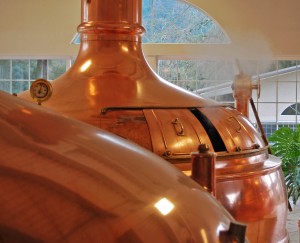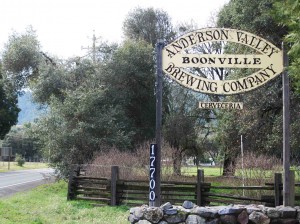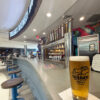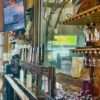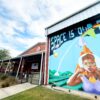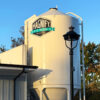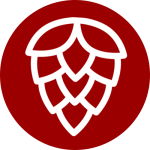When I made the trip up to Boonville (about 2 and a half hours north of San Francisco) to visit the mythical Anderson Valley Brewing Company, I wasn’t sure what to expect. What I did find was that after that long drive – including a 30 minute twisting trek through the mountains, was that their taproom was closed that day due to reduced winter hours.
I went into the office and sort of pleaded with Debbie there if she could find someone to show me around a little bit. She said she would try to find someone, after lunch, and to come back in a little while. FYI – Boonville is VERY small, and in the winter, most everything is closed, but I found a nice spot for organic iced tea and a wrap, and waited.
My patience was more than rewarded when after waiting in the office again for a little while, the Head Brewer Fal Allen walked in, introduced himself, then agreed to share some of his time with me. Fal has been well known in craft brewing circles since he started brewing in the late 80’s in Seattle (Red Hook and Pike’s) then in 2000 when he took the helm at Anderson Valley and helped shape them into one of the highest quality and most revered award winning breweries in the nation. After taking a couple of years in Singapore to develop a brewery there, he came back to Anderson Valley about the same time as new ownership took over.
At first it appeared that Fal wasn’t in the brightest mood, which quickly passed as he showed off his brewery’s solar array, his project of converting an old 80 bbl brew kettle to a mash tun (so they can lauter into a separate vessel), his new canning line, on-going waste water recovery system, hop back and other unique and wonderful aspects of this great brewery. And, as it turns out Fal manages just about all of it – everyday (his recent unhappiness it turned out was a result of someone at the brewery inadvertently pouring glue on the floor). “I sometimes think that I really shouldn’t be called the brewmaster, cause I am really more of a plant manager, don’t get to spend that much of my time actually brewing”, he explained.
He proudly showed me his rack of barrel aged Saison’s (apricot and raspberry) that were dosed with wild yeast and had been sitting outside for almost a year. He told me that the new ownership was more interested in barrel aging – which was fine with him, as he – along with Vinnie Cilurzo of Russian River and Tommee Arthur of Port and other local brewers, helped to pioneered the practice years ago.
Nestled In the somewhat remote but lovely Anderson Valley, the Brewery is dependent on local well water, propane and solar panels for it’s energy. “We used to create about 60% of our power from the solar panels, but we’ve been expanding, so it’s down to about 40% — but we are adding more panels later next year”.
AVB and Fal’s commitment to “Green Brewing” includes their canning line which Fal would like to see used for even more output. “It’s great, cheaper to ship, better to recycle, and we can easily recycle any rejected materials – if we can get our steam roller running”. I asked him if he thought that the canned “Hop Ottin” IPA was somehow “better” than the bottled version – and he said that “maybe in the first couple of weeks in the can it tastes a little fresher, but otherwise it’s pretty much the same”.
As we checked out the huge bin of whole hop flowers ready to add to the Belgian Trippel boiling away in the kettle, Fal proudly pointed out that they still used whole flowers and still used a hop back – though it wasn’t the cheapest or easiest process – but that it added natural character he really liked. My impression was that this was an example of what made Fal and AVB’s beer so great – doing the right thing, staying as close to natural as possible, and above all true dedication to making the best beer anywhere.

